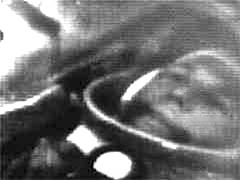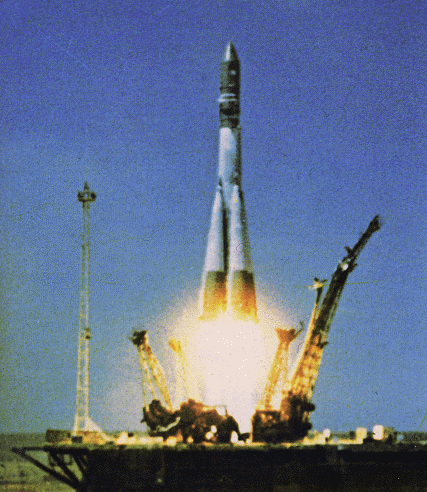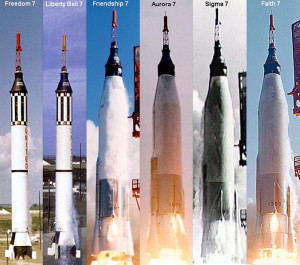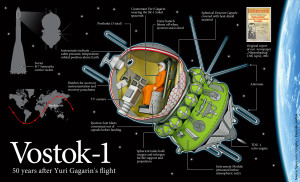The year was 1961. The Cold war was at it’s peak intensity, and both the Soviet Union and the United States were rushing to prove their technological superiority by putting a human into space. It was 3 years since Sputnik, since Explorer 1, and in that time both United States and Soviet booster, life support, and re entry technology had improved quite a bit.
It takes incredible technology to even get into space, and equal technology to keep someone alive up there. This all comes at a cost, as well, in the form of weight. The boosters of the era were designed to sent nuclear weapons halfway around the world to attack the enemy. While they could have their trajectories changed to enter orbit (as was done in 1957 with the R-7 ICBM and Sputnik 1) this entailed a limit to the amount of weight the missile could carry successfully into orbit.
The Soviets already had a powerful booster int he form of the R-7, and with the addition of upper stages, they were able to put up vastly larger payloads than the Americans could. At the time, we were still in the final phases of our own ICBM Programs; Atlas and Titan. Atlas was started first, and Titan was begun later as a backup program.
In the late 1950’s, at the same time Atlas was being designed, and the beginnings of our manned space flight program were coming together, a little one man capsule was being designed; Mercury. It was tiny, it was limited, but it could get a man into space and bring him back. The problem is Atlas wasn’t ready for manned flight, failing more often than it had successful launches, so what would we do? Sub-orbital flights with the weaker Redstone missile.
After a near disaster test with Ham, the chimpanzee, on January 31st of 1961 (another strange coincidence with my birthday), the first manned US flight, with Alan Shepard, was delayed so that the high acceleration problems in that test flight could be worked out. This delay was the moment the Soviets took another lead in Space flight.
The Soviets had already done several unmanned orbital test flights of their spacecraft, called Vostok. Interestingly, since everything the Soviets did in space flight was a military project, the entire vehicle was officially designed as a variant to a spy satellite known as Zenit, or so the story goes. It was a design able to send up, and return, a useful payload, regardless of the origin, and as such, was of use to the Soviet Military. Upstaging the Americans in technology was seen as an added bonus, insult to injury, if you will. After all, at this time, even though the Soviets had only a few ICBM’s ready at any given time, their propaganda led us to believe there truly was a missile gap, and that we were lagging behind them both in quality and quantity of boosters. We would eventually learn this was not true, but at the time, it was a terrifying though, I’m sure.
On April 12th 1961, Yuri Alekseyevich Gagarin boarded the waiting Vostok booster and spacecraft, and rode it into history. 1 orbit of the Earth. It wasn’t much, but it was the first time any human had ever done such. While he had only emergency control of the craft, he was still in there, still flying around the planet. At that moment, humanity first truly left the cradle that is Earth, if even for a short time.
The flight was mostly uneventful, save for the equipment module not separating properly, which could have been fatal – thankfully the heat of re-entry did cause the module to separate and the craft returned safely, with Gagarin ejecting for his own parachute landing separate from his space craft. For flight records purposes, the Soviets lied about this element of the flight, but in personal historic retrospective, I think we all can let that slide simply for the sake of the design limitations of those early craft, and the significance and unique nature of any such flight.
The United States would make it’s first sub-orbital flight on May 5th 1961, and would not make an orbital flight until Feburary 20th 1962. While Vostok would go on to fly 5 more times, spending days in orbit, and with 2 pairs of dual launch missions, including the first woman in space, Mercury would spend at most a day in orbit over it’s next 4 launches.
In the mid 1960’s, the Soviets would fly a modified version of Vostok, known as Voshkod, for 2 historic flights – the first 3 man crew, and the first walk in space. The United States, working hard on our Apollo program to get to the Moon, would make what was effectively a re-designed, heavily upgraded and expanded Mercury, to be known as Gemini. This 2 man vehicle was everything Voshkod was not, and would make 10 generally successful manned flights before the Soviets would come back with their new vehicle, the Soyuz. 1967 looked to be the year that the space race would enter the final stretch, but, as history shows, disasters on both sides would alter the path history would take to its then-unknown outcome.
 Sadly, Gagarin would never make another space flight. He was backup for the ill fated Soyuz 1 flight, and was planning for future flights when his training aircraft mysteriously crashed in 1968. He was known to be a very skilled pilot, which makes many wonder just what actually may have gone on in his death.
Sadly, Gagarin would never make another space flight. He was backup for the ill fated Soyuz 1 flight, and was planning for future flights when his training aircraft mysteriously crashed in 1968. He was known to be a very skilled pilot, which makes many wonder just what actually may have gone on in his death.
Those are other stories for other times, though. For now, let us focus back on one of the singular greatest events in human history. Vostok 1. The moment our dreams of flying reached beyond our world, and to the stars. What was simply a Soviet propaganda move, in the end, was nonetheless an event that would spark generations to look up, not just dreaming of the stars, but actually reaching for them.
https://www.youtube.com/watch?v=1YclWS3ZIio







